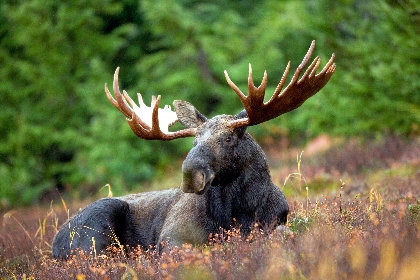Man’s interaction with wilderness usually goes something like this; man discovers wilderness, man tries to tame wilderness, man hunts and wipes out many species in this wilderness, then man realizes what has happened and desperately tries to make up for what he has done. Moose, among many other mammals in the Adirondacks have been wiped out and reintroduced in this standard fashion.
In most cases, initial population decimations of moose are easily traced back to hunting. As more people traveled into the Adirondacks and attempted to make a living off this wilderness, hunting became an economic staple. During the early years of settlement, beaver, moose and deer pelts were popularly traded goods, while in later years, hunting evolved into a recreational pastime for vacationers. Sportsmen and their guides traveled into the wilderness in search of big game, and moose were a common target. However as these populations declined, the missed presence of key Adirondack species led to reintroduction efforts; producing mixed results. In some cases, such as that of the beaver, reintroduction brought populations to a sustainable number, while in the case of the wolf, reintroduction efforts have not gotten past the initial controversy posed by this idea.

However, of the numerous species of native animals in the Adirondacks threatened by the activity ofman,the moose has a tale that is slightly more optimistic. The moose were exterminated from the Adirondacks in 1861, and yet more than 100 years later, moose have made their way back to the Adirondacks region with no initial help from man (Lee 1). Despite the successful population growth of this animal, there are still many concerns that arise from supporting the establishment of these new moose populations. The Adirondacks are a patchwork of public and private lands, a feature which makes it hard to contain moose solely to areas that are not inhabited. Therefore, human populations in the Adirondacks must be taken into account to ensure that moose do not endanger humans, and humans do not endanger moose through unintentional actions such as vehicle collisions. There are additional threats to moose that must also be taken into account in order to ensure that populations remains stable. However tedious this process might be, protecting this species is ultimately a worthwhile endeavor. Moose attract tourists in hope of a photograph to the Adirondacks, increasing revenue in the park and outsider interest in preserving the region. Besides these economic benefits, moose ultimately have a rightfulplace in the ecosystem of the Adirondacks and their fate should not be dictated by man's desire to conquer wilderness. Efforts should continue to be made to further the re-establishment and health of this species’ population.
_______________________________________________________________________________________________________
Sources Cited:
"Alces alces alces Myre Norway." Wikipedia Commons. Wikipedia, 22 Mar. 2011.
Web. 11 May 2015.
Lee, Gary N. "Moose Population Growing in the Adirondacks." Adirondack Outdoors. N.p., n.d. Web. 5 Apr. 2015.
Male Moose. Wikipedia Common. Wikipedi, 30 Jan. 2012. Web. 11 May 2015.
Ritchie, Stephan. "Adirondack Colors." Flickr. Yahoo, 11 Oct. 2009. Web. 12 May
2015.
89kJ1-pMAoCy-q54M4h-q54LN7-p89ked-pMxssS-q54Le1-pMyJdg-pMAne1-pMyHRV-q54KvY-pMviE
r-q4VGLi-p8bTKF-pMyGSF-q4VGAt-q54JDC-pMAm6u-p8bTxM-p89hYG-q54JxA-q4VGqZ-p89hTm-jL
5YZj-fktVvd-jYFh8Z-6QUoPT-km3Qqf-p89hTS-p8bTng-q2QkUb-p8bSJc-p8bSri-q2Qkow-q2Qk5W
-pMAjwC-pMyEDH-q54G1S-pMyE1Z-p8bQpn>.

